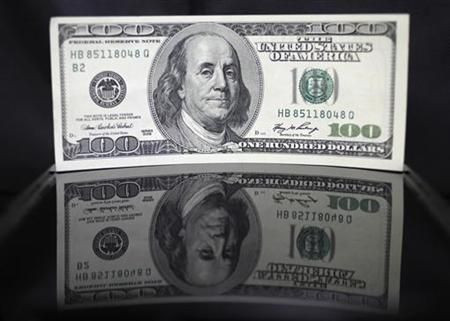U.S. Dollar, U.S Treasuries Gaining in Favor Against Gold - Analyst

As Europe's debt crisis deepens, low-yielding U.S. government debt and the much maligned dollar are suddenly glowing more brightly than gold.
After surging to a record high above $1,900 an ounce this month, gold has shed about 8 percent over the past two weeks, with about a quarter of that decline coming on Monday.
Instead, investors snapped up long-dated Treasuries, and poured into the dollar even though the Federal Reserve has all put promised to keep short-term interest rates near zero until at least mid-2013.
It's a very unsettled world out there, said Wan-Chong Kung, senior portfolio manager at Nuveen Asset Management in Minneapolis, an affiliate of Nuveen Investments, which oversees $210 billion (134 billion pounds) in assets. There are precious few true safe havens in the minds of investors.
Over the last few months, gold had been viewed as one of the most solid of safe havens, particularly at a time when developed countries saddled with slow growth and high debt have been trying to inject life into their economies and export sectors with weaker currencies.
For some, worries that massive monetary and fiscal stimulus would eventually stoke inflation also pushed gold higher.
But fear that a Greek default would push other indebted euro zone countries further into distress and spark losses across the European banking system has investors falling back on the depth and safety of the dollar.
People are moving straight to cash instead of looking at alternative safe assets like gold, said David Meger, metals trading director at Chicago's Vision Financial Markets.
Money managers summed up their own cautious views.
I've pulled in my horns a bit, staying fairly close to neutral, said Gregory Whiteley, who manages a government bond portfolio for Los Angeles-based DoubleLine Capital, with $16 billion in assets. The thing in the back of my mind is this situation in Europe.
Dan Fuss, vice chairman of Loomis Sayles, which oversees over $160 billion in assets, told Reuters the firm began increasing its U.S. dollar-asset exposure during the summer as unease about Europe and the U.S. economy started to grow.
Loomis' dollar exposure has climbed from 60 percent to 70 percent while non-dollar exposure dropped from 40 percent to 30 percent, Fuss said.
We increased our exposure in U.S. dollar-assets also because the world got a little bit scarier, he said. These are short-term tactical moves. That said, the U.S. is still far and away the best credit in the world.
John Taylor, chief executive officer of the $8 billion currency hedge fund FX Concepts, said on Monday he was still long U.S. dollars. Taylor, who predicted late last year that the United States could enter another recession in 2011, also said he continues to be bearish on U.S. stocks.
CASH IN, CASH OUT
Some said gold's decline may be a sign that investors who jumped on the bandwagon early enough are booking some profits.
Gold entered the year trading around $1,400 an ounce and has risen steadily since. Its gains picked up speed over the summer, hitting a record above $1,920 this month.
Gold has lost a bit of its shine, but it's one of the few assets that has posted any sort of return for anyone lately, said Greg Salvaggio, vice president of currency trading at Tempus Consulting in Washington.
I mean, trading currencies? Good luck. And you had PIMCO telling people four months ago to sell Treasuries, he said.
In fact, gold may have been one of the few things investors could sell to offset losses in stocks or other risk assets, said Adnan Akant, head of foreign exchange at Fischer Francis Trees & Watt, a New York unit of BNP Paribas with about $48 billion under management.
After Lehman Brothers collapsed in mid-September 2008, he said gold initially shot up about 15 percent as investors scrambled for safety. By the end of October that year, though, it lost 20 percent as investors had to meet margin calls or unwind risky trades.
You get jittery, volatile moves like we're seeing now and people have to sell what they own, he said.
A similar mechanism has tended to boost the dollar in times of stress because investors who borrowed it at record low interest rates to buy higher-yielding assets have to rush to buy it back when those assets start to decline in value.
The Swiss franc is also a traditional safe haven, but the Swiss National Bank has intervened to weaken it against the euro, pushing even more safe haven flows towards the dollar
DOLLAR COULD WEAKEN
If risk sentiment improves or the Federal Reserve surprises this week by announcing even more aggressive monetary easing than the market expects, the dollar could weaken again.
Gold, traders said, may be set for a rebound if it hits $1,700 an ounce as buyers look to position for future gains. It was last at $1,778.49.
For now, though, it is tough for investors to turn their backs on Treasuries, even if they would rather deploy their funds more lucratively elsewhere.
Whiteley said record low U.S. rates make it tempting to lessen exposure to longer-dated Treasuries that pay such meagre returns.
But as we see time and again, you come in each morning and the 30-year is up another point because of negative developments in Europe, he said. That will probably get uglier, which makes it dangerous making an interest rate bet.
© Copyright Thomson Reuters {{Year}}. All rights reserved.






















